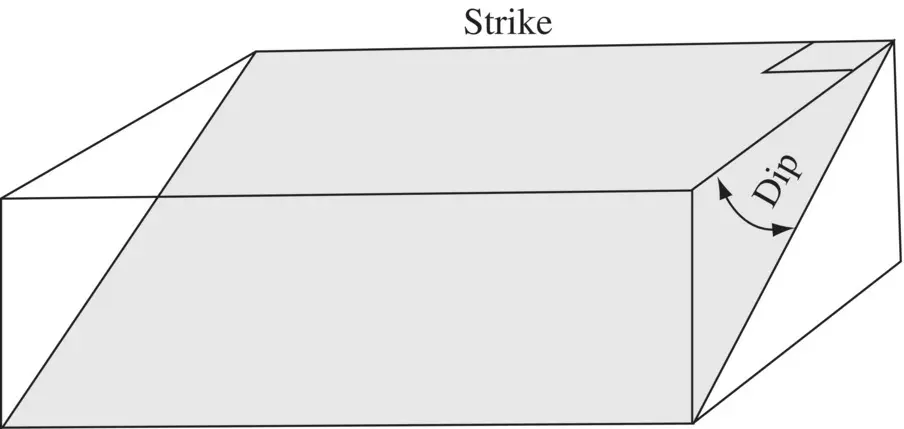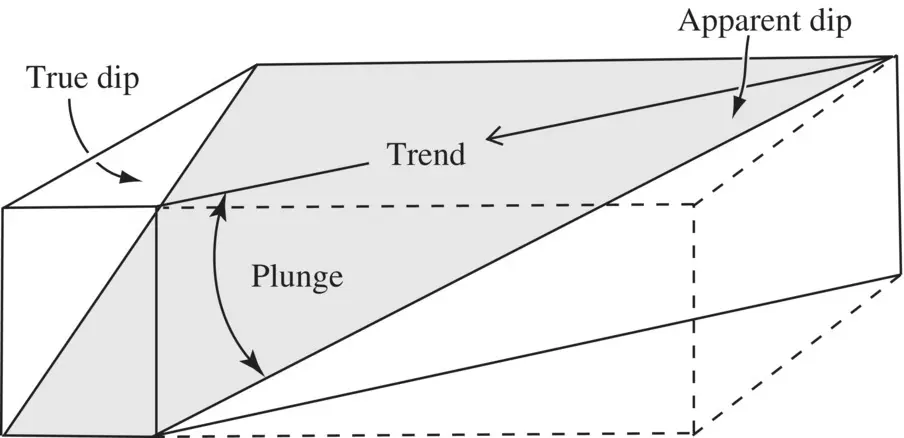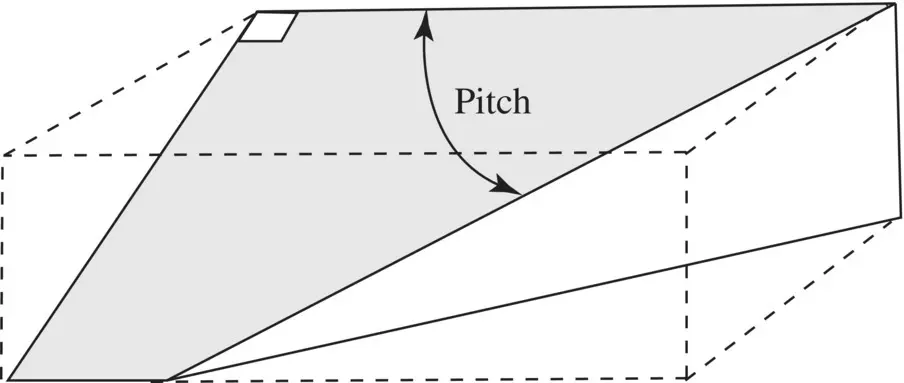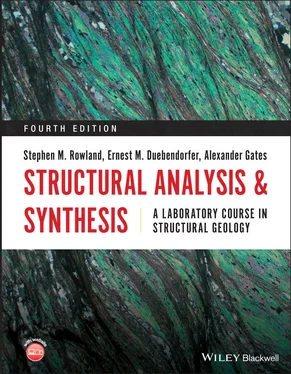There are two ways of expressing the strikes of planes and the trends of lines ( Figure 1.3). The azimuth method is based on a 360° clockwise circle and the quadrant method is based on the four 90° compass quadrants – north, south, east, and west. The quadrant system is the most commonly used in the United States, but in other countries the azimuth system is the convention. Strikes are traditionally measured from the north‐half of the transit or compass, but it is understood that the line extends in both directions. Unless horizontal, trends must be measured from the direction that they plunge, so they can be in any direction.

Figure 1.1 Strike and dip of a plane.

Figure 1.2 Trend and plunge of an apparent dip.

Figure 1.3 Azimuth and quadrant methods of expressing compass directions.
A plane that strikes due northwest–southeast and dips 50° southwest could be described as 315°, 50°SW (azimuth) or N45°W, 50°SW (quadrant). Similarly, a line that trends due west and plunges 30° may be described as 30°/270° in azimuth (sometimes written as 30° → 270° or 30°, 270°) or 30°/N90°W in quadrant. For azimuth notation, always use three digits (e.g. 008°, 065°, 255°), so that a bearing cannot be confused with a dip (one or two digits). In this book, the strike is given before the dip, and the plunge is given before the trend. We recommend that you use the azimuth convention in your work. It is much easier to make errors reading a bearing in quadrant notation (two letters and a number) than in azimuth notation (a single number). In addition, when entering orientation data into a computer program or spreadsheet file, it is much faster to enter azimuth notation because there are fewer characters to enter.
 The method for measuring planes and lines in the field is to use a pocket transit or a modified compass with a clinometer. Video 1 https://youtu.be/QSrmwSot7Oscontains instructions on how to measure lines and planes in the field using both devices. An alternative method of measuring and representing strike and dip is the right‐hand rule. The right‐hand rule requires that you view and measure the strike direction so that the surface dips to your right. For example, the attitude of a plane expressed as 040°, 65°NW could be written as 220°, 65° using the right‐hand rule convention because the 65°NW dip direction would lie to the right of the 220° strike bearing. The system eliminates the need for dip direction. A third but less popular method is dip/dip direction. In this case, the dip angle and its direction (declination) are measured. The dip direction is perpendicular to the strike, so no dip direction is required for this method either. In areas of low dip angles, this can be a simpler and more accurate system because the strike of planes with low dip angles can be difficult to measure and may result in significant errors.
The method for measuring planes and lines in the field is to use a pocket transit or a modified compass with a clinometer. Video 1 https://youtu.be/QSrmwSot7Oscontains instructions on how to measure lines and planes in the field using both devices. An alternative method of measuring and representing strike and dip is the right‐hand rule. The right‐hand rule requires that you view and measure the strike direction so that the surface dips to your right. For example, the attitude of a plane expressed as 040°, 65°NW could be written as 220°, 65° using the right‐hand rule convention because the 65°NW dip direction would lie to the right of the 220° strike bearing. The system eliminates the need for dip direction. A third but less popular method is dip/dip direction. In this case, the dip angle and its direction (declination) are measured. The dip direction is perpendicular to the strike, so no dip direction is required for this method either. In areas of low dip angles, this can be a simpler and more accurate system because the strike of planes with low dip angles can be difficult to measure and may result in significant errors.
There is a problem measuring declinations because they are meant to be from the geographic North Pole, but a compass or transit measures from the magnetic North Pole. These devices must be adjusted to correct for the difference in location between the poles. The closer the measurement is made to the poles, the more pronounced the correction may be, and the current rapid wandering of the magnetic North Pole is further complicating data collection. There are apps available for smartphones to measure orientations that do not require corrections, but they tend to be less accurate and subject to cell phone coverage. Because inclinations are relative to the earth surface at a specific location, they are only comparable locally. Relative to a fixed point in space, a 30° dip at one location would not be parallel to a 30° dip measured 1000 km away.
The following terms are used to describe the orientations of lines and planes. All of these are measured in degrees, so values are typically followed by the degree symbol (°).
AttitudeThe orientation in space of a line or plane. By convention, the attitude or orientation of a plane is expressed as its strike and dip; the attitude of a line is expressed as trend and plunge. (syn: orientation). BearingThe declination or horizontal angle between a line and a specified coordinate direction, relative to compass directions or in azimuth. StrikeThe bearing of the line of intersection of an inclined plane with the horizontal plane or surface ( Figure 1.1). The strike is a line of equal elevation on a dipping plane. DipThe vertical angle between an inclined plane and a horizontal line perpendicular to its strike. The maximum angle of inclination on an inclined plane. The direction of dip can be thought of as the direction water would flow down the plane ( Figure 1.1). TrendThe bearing (compass direction or declination) of a line ( Figure 1.2). Non‐horizontal lines trend in the down‐plunge direction. PlungeThe vertical angle of inclination between a non‐horizontal line and the horizontal ( Figure 1.2). PitchThe angle measured within an inclined plane between a horizontal line and the line in question ( Figure 1.4). Also called rake. Apparent dipThe vertical angle between an inclined plane and a horizontal line that is not perpendicular to the strike of the plane or in true dip direction ( Figure 1.2). For any inclined plane, the true dip is always greater than any apparent dip. Note that an apparent dip may be defined by its trend and plunge or by its pitch within a plane. 
Figure 1.4 Pitch (or rake) of a line in an inclined plane.
Translate the azimuth convention into the quadrant convention, or vice versa.
1 N12°E
2 298°
3 N86°W
4 N55°E
5 126°
6 N37°W
7 233°
8 270°
9 083°
10 N3°W
Circle those attitudes that are impossible (i.e. a bed with the indicated strike cannot possibly dip in the direction indicated).
1 314°, 49°NW
2 086°, 43°W
3 N15°W, 87°NW
4 345°, 62°NE
5 062°, 32°S
6 333°, 15°SE
7 089°, 43°N
8 065°, 36°SW
9 N65°W, 54°SE
Fault surfaces can contain slip lineations (fault striae). Such slip lineations can be used to determine the orientation of a slip on a fault and, therefore, whether the motion on the fault was strike‐slip, dip‐slip, or oblique‐slip. A geology student who was just learning to use a pocket transit recorded the orientations of five slip lineations on one fault surface. The strike and dip of the fault surface is 320°, 47°NE. The student’s five recorded lineation orientations are recorded in the table below.
Читать дальше




 The method for measuring planes and lines in the field is to use a pocket transit or a modified compass with a clinometer. Video 1 https://youtu.be/QSrmwSot7Oscontains instructions on how to measure lines and planes in the field using both devices. An alternative method of measuring and representing strike and dip is the right‐hand rule. The right‐hand rule requires that you view and measure the strike direction so that the surface dips to your right. For example, the attitude of a plane expressed as 040°, 65°NW could be written as 220°, 65° using the right‐hand rule convention because the 65°NW dip direction would lie to the right of the 220° strike bearing. The system eliminates the need for dip direction. A third but less popular method is dip/dip direction. In this case, the dip angle and its direction (declination) are measured. The dip direction is perpendicular to the strike, so no dip direction is required for this method either. In areas of low dip angles, this can be a simpler and more accurate system because the strike of planes with low dip angles can be difficult to measure and may result in significant errors.
The method for measuring planes and lines in the field is to use a pocket transit or a modified compass with a clinometer. Video 1 https://youtu.be/QSrmwSot7Oscontains instructions on how to measure lines and planes in the field using both devices. An alternative method of measuring and representing strike and dip is the right‐hand rule. The right‐hand rule requires that you view and measure the strike direction so that the surface dips to your right. For example, the attitude of a plane expressed as 040°, 65°NW could be written as 220°, 65° using the right‐hand rule convention because the 65°NW dip direction would lie to the right of the 220° strike bearing. The system eliminates the need for dip direction. A third but less popular method is dip/dip direction. In this case, the dip angle and its direction (declination) are measured. The dip direction is perpendicular to the strike, so no dip direction is required for this method either. In areas of low dip angles, this can be a simpler and more accurate system because the strike of planes with low dip angles can be difficult to measure and may result in significant errors.










